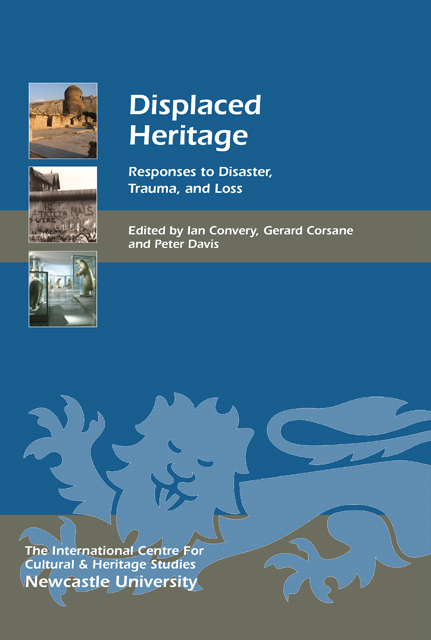Book contents
- Frontmatter
- Contents
- List of Illustrations
- Acknowledgments
- List of Abbreviations
- Preface
- Introduction
- Displaced Heritage: Histories and Tourism
- Displaced Heritage: Trauma, Confinement and Loss
- Displaced Heritage: Lived Realities, Local Experiences
- Displaced Natural Heritage
- Endpiece
- List of Contributors
- Index
- Heritage Matters
7 - Remembering Traumatic Events: The 921 Earthquake Education Park, Taiwan
Published online by Cambridge University Press: 24 February 2023
- Frontmatter
- Contents
- List of Illustrations
- Acknowledgments
- List of Abbreviations
- Preface
- Introduction
- Displaced Heritage: Histories and Tourism
- Displaced Heritage: Trauma, Confinement and Loss
- Displaced Heritage: Lived Realities, Local Experiences
- Displaced Natural Heritage
- Endpiece
- List of Contributors
- Index
- Heritage Matters
Summary
Introduction
Items of material culture are often preserved to sustain desired memories, or discarded or destroyed to suppress those that society wishes to forget (Foote 1988). Although few in number, there are museums dedicated to preserving, displaying and interpreting mankind’s experience with natural disaster and tragedy. These include interpretive centres dedicated to interpreting earthquakes and volcanic eruptions, explaining conditions leading up to a disaster and its impact on the environment and society. Natural disaster museums help facilitate the reconstruction and interpretation of specific tragic events in order to help visitors re-experience and interpret the painful experience. Because of their organisational nature and created public space, natural disaster museums also provide an important venue for the public to reflect on the history, to consolidate national sentiment and to shape collective memories (Chen 2007).
Measuring 7.2 on the Richter scale, the Jiji Earthquake that struck Nautou County in Central Taiwan on 21 September 1999 led to 2415 deaths, injured 11,305 people and caused irreparable damage to 51,711 homes. The scale of the disaster deeply affected the whole of Taiwanese society and formed a collective memory of loss and trauma. Cities near the epicentre (including Nantou, Taichung and Changhua counties) were most severely damaged, although other cities were also hugely affected (see Fig 7.1). In Taipei, far from the epicentre of the quake, buildings shook severely and five buildings collapsed, including the twelve-storey Tunghsing Building, with 87 people dying among the rubble of the building.
In the wake of the so-called 921 Earthquake, the national Ministry of Education proposed to build an earthquake museum to preserve and display the remains of earthquake-ravaged Guangfu Junior High School in Wufeng, a township in southern Taichung County (Chou 2002). Today, the 921 Earthquake Education Park not only displays earthquake damage but also features educational exhibits designed to inform and console visitors. What in the social milieu makes it possible to establish a museum, and how do communities respond to such a decision? How does the 921 Earthquake Education Park employ and display exhibits to communicate earthquake information and interpret shared societal memories of pain and loss? How does the public, and those currently working as 921 Earthquake Education Park volunteers in particular, interpret museum-provided information and memories through exhibits? These are the research questions that will be explored in this chapter.
- Type
- Chapter
- Information
- Displaced HeritageResponses to Disaster, Trauma, and Loss, pp. 71 - 82Publisher: Boydell & BrewerPrint publication year: 2014

